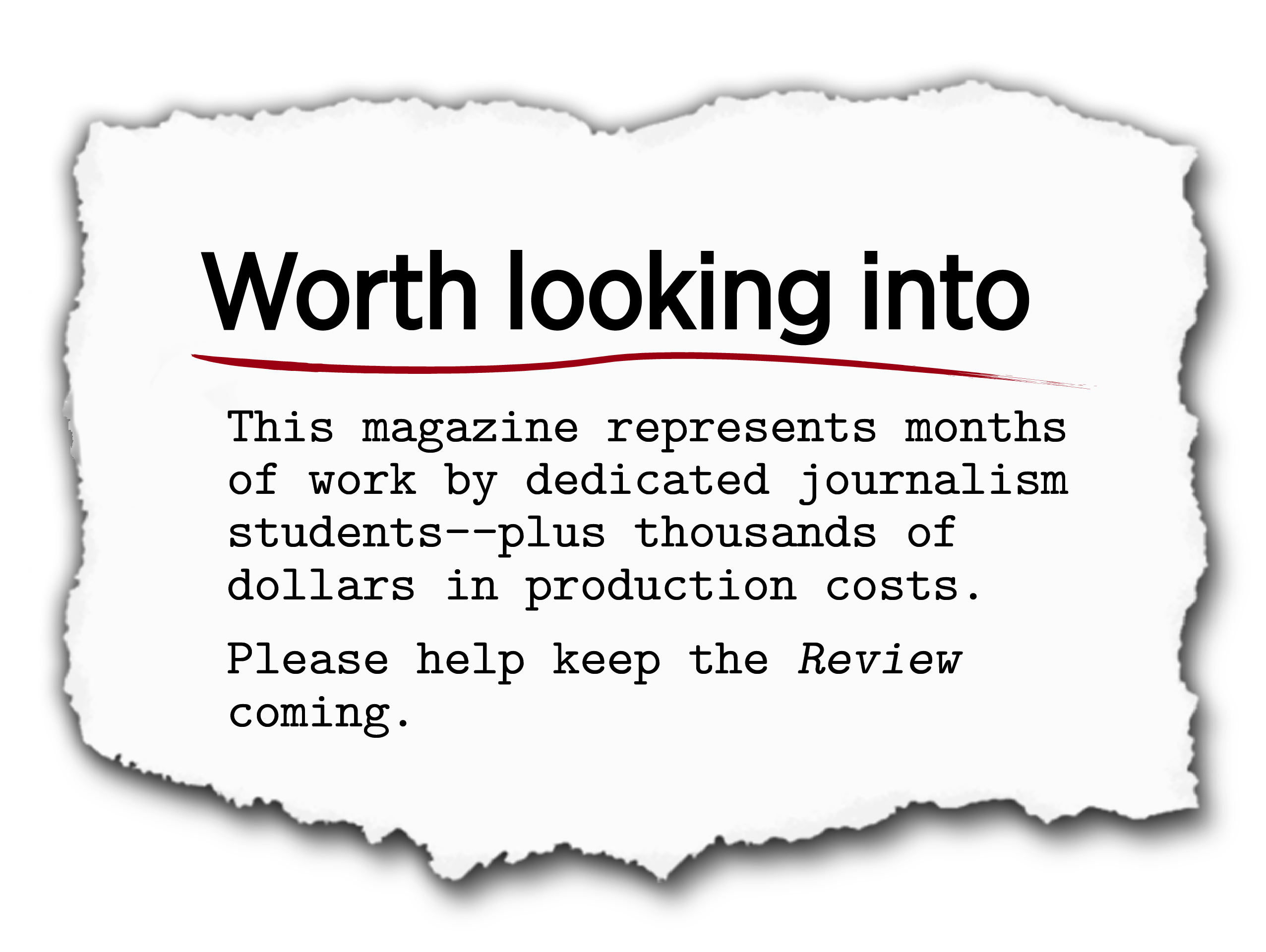Right to Know
Damned by all for their handling of the Homolka publication ban, are the media in fact on the side of the angels?
They have been accused of reprehensible behaviour, of using a self-serving principle to profit from tragedy. They have been blasted for lacking the courage of their convictions, for inadequately defending freedom of the press. In protesting the most notorious publication ban in Canadian history, have the media gone too far or not far enough?
Although Karla Homolka was convicted of manslaughter in July 1993 for her role in the sex-slayings of two Ontario schoolgirls, our press has been forbidden to report the details of that role until her ex-husband, Paul Bernardo, faces charges of first-degree murder for the same deaths. (His trial is expected to begin in May.) For almost two years, the big media players have attacked the court’s ruling as an obstruction of a free press. They have argued in editorials, and before the Ontario Court of appeal.
When the appeal court refused to overturn the ban, the media continued to protest in print and on the air, making the Homolka publication ban a cause célèbre. Everyone knows about it. Everyone has an opinion. When I began work on this story, my take on the ban could only be described as ambivalent. Freedom of the press sounded like a good principle, but surely there were times when that principle should yield to higher interests. That changed. As I immersed myself in the research, I began to move towards a strong anti-ban position. I believed the media could have and should have done more. But by January, on my third draft, the weight of events and evidence led me to a different conclusion.
Have the media gone too far? Not far enough? Another look provides some interesting answers.
In justifying their attack on the ban, newspapers in particular like to argue that “the public has the right to know.” But a vocal segment of the public does not want to know. In a letter to The Toronto Star, Sean Martin asked: “Is there anything intrinsically wrong with honoring the ban until the Paul Bernardo case is over? Or are you so obsessed with the potential profit margin of this story that you can’t fathom the judge’s extremely simple logic in imposing it?” In a letter to The Globe and Mail, Glenn R. Brown suspected the press of using high principles to conceal base motives: “…we who have seen what the press is doing with the O.J. Simpson trial and what the press has already done with the Karla Homolka proceedings, do not seriously believe that these principles are foremost in the minds of the press. Greed and selling papers are primary; helping the public to monitor the justice system has little to do with it.”
To some degree, the media have encouraged this bitter skepticism by sending the public mixed messages. They claim to be protesting on behalf of pillar-of-democracy principles, yet operate independently of each other, plotting their own responses to the ban and looking after their own interests. “In very, very, very few circumstances do I get a call from anybody else or do I call anybody else on these things,” says Globe managing editor John Cruickshank, “simply because we’re all quite different institutions. We do view the issues quite differently.” For example, newspapers may agree to fight for the release of Homolka’s statement to the court, but differ on whether to fight for the release of victim impact statements, he says, “It seems to me that there are tremendous practical difficulties in that sort of thing in achieving that kind of consensus. I’m not prepared in a case of this complexity to give away the right of Globe and Mailto instruct its own counsel so that the interests of The Toronto Sun can be served, or the interests of [radio station] CFRB, or whoever else gets into it.”
Infighting between the Star and the Sun only helped to persuade the public that self interest, not selfless principles, was behind the media’s anti-ban campaign. In October 1994, the Star lashed out at the Sun for its irresponsibility in publishing information about recently discovered videotapes at the former home of Bernardo and Homolka — information that Star reporters claim to have had, but withheld in deference to the ban. Part of the Star’s article read: “[Bernardo] Lawyer John Rosen immediately blasted the story, saying in an interview that it might hurt Bernardo’s chances of getting a fair trial.” Between the lines, readers knew the Starwas ticked off that the Sun dared to run the scoop. Sun managing editor Mike Strobel calls the squabble “silly,” but he shrugs it off as routine behaviour among the media. “It was just one newspaper taking shots at another because the other newspaper beat it.” Alan Cairns, who has covered the Homolka story for the Sun, bluntly characterizes the level of cooperation among newspapers: “The other media would dearly love to see one of their competitors pinned to the dartboard.”
However routine the infighting, it looked ruthless to the public, confirming its belief that the press is bent on revealing every last detail of the sex-slayings, even if it means destroying Paul Bernardo’s right to a fair trial. Some lawyers, such as Bill Trudell, vice-president of the Criminal Lawyers Association, give grounds to that fear. “Let’s say John Smith was charged with something and it’s like a Paul Bernardo situation,” he explains. “There was a publication ban to preserve the rights of this person to have a fair trial. It also preserves the right of the Crown to prosecute it, right? So all of a sudden, if something was exploded now at about what went on in the back rooms or something was botched, it may prejudice not only John Smith’s right to a fair trial, it may mean that the Crown can’t prosecute and maybe somebody who’s guilty of something — or would be found guilty of something — goes free.”
The public may be surprised to learn that its concern is shared by some of the journalists who are covering this story. “We do not want to impact on any fair trial arguments for Paul Bernardo,” says reporter Alan Cairns. “If Paul Bernardo is acquitted, The TorontoSun doesn’t want to be singled out as the main reason why.” Star reporter Nick Pron has never hidden his contempt for the publication ban, but he says: “I have to admit, I go back and forth on the ban sometimes. I mean, I’m against it —but sometimes I can sort of see why they did it.” Their ambivalence reflects an honest struggle. The Homolka ban is a difficult issue. I know of at least two anti-ban journalists who have flipped their opinion and now support it. But whether they are for or against, I have been struck by the level of thoughtfulness that journalists have brought to the ban debate, a thoughtfulness that belies the salacious and greedy motives ascribed to them. Most believe, deeply, that the ban is a threat to our notion of democracy and prevents the public from receiving information it needs to know today, not after the trial. Jill Troyer, executive producer of Toronto’s CBC Evening News, says, “Our justice system is based on being open. People have to know what’s happening in the court system so that they can see whether justice has been done, so that they’re in the position to make judgments about our laws and about the way that they’re handled and about the way they’re followed through.” If the public can’t see that, Troyer continues, then you’re. into a situation “where justice has been conducted behind closed doors and in secrecy, and there’s no public accountability.”
Colleen McEdwards is an articulate and thoughtful reporter who covered the Homolka proceedings for the Evening News. “I’m not really that concerned about reporting all the gory details about what happened to those girls,” she says. “I don’t think the public needs to known that now.” However, she opposes the ban because it prevents her from conveying facts that she believes should be open to public scrutiny — immediately. “Without getting into specifics, there are aspects around the sentencing of Karla Homolka that the public ought to know that I can’t report.”
The Globe’s John Cruickshank is less guarded. “One of the real fundamental issues is the handling of [the Homolka case] — the deal-making, the conduct of the Crown, the effectiveness of the police. These are all issues that we should be able to pursue at the instant.”
Although Cruickshank says letters to the editor, like the angry one written by Glenn Brown, are representative of a big chunk of public opinion, she sees no contradiction between selling newspapers and fighting for principles. “I really don’t have any serious discussion with people who say ‘you just want to sell papers’ because my response is, ‘of course I want to sell papers. I can’t inform the public unless I sell papers.'” He adds: “I could very safely say that the paper’s revenues and profits are not going to be influenced in any way by the Homolka ban, but justice — as it operates in this country — will be.”
Freedom of the press is not as highly valued by the Canadian public as it is by the press. When the principle is threatened, as it has been during several recent publication bans, there are no demonstrations; passions stay cool. This complacency disturbs the Sun’s Cairns. “Where is the public?” he asks. “The public should be looking at this case very, very carefully. And from what I see, they may be reading and looking and listening, but they sure as hell aren’t doing anything.”
According to writer and columnist Robert Fulford, the Homolka publication ban is a spectacularly repressive measure. “It calls into question the whole relationship between the public and the justice system,” he says. “We have to know what they’re doing; it is very wrong when we do not. They have so delayed our full knowledge of this that it will become a matter of historical interest by the time we understand what the hell this case is all about. That’s wrong. That’s exactly what a criminal justice system in a democracy must not do.” He dismisses the idea that a publication ban is necessary to protect Bernardo’s right to a fair trial.”Jurors may go into a courtroom with ideas about who did it and who didn’t do it. But what happens in a courtroom during a murder trial is so intense, so powerful in its amassing of detail, in its development of argument — it is so powerful an experience that, I believe, it wipes out what you brought in.”
The highest court in Canada recently agreed. In December 1994, the Supreme Court of Canada released its long-awaited decision on The Boys of St. Vincent publication ban, which the CBC had appealed the previous year. The Boys of St. Vincentis a fictional mini-series concerning the abuse of children in a Catholic orphanage in Newfoundland. Two days before CBC Television was to broadcast the first of two installments, four Christian Brothers, who were facing criminal charges of sexual and physical abuse of children, won a legal injunction that prevented the CBC from broadcasting the mini-series in Ontario and Montreal until their trials were completed. Their reason for seeking the publication ban: The mini-series would influence the jury and therefore infringe upon their right to a fair trial.
In its decision on the appeal, the Supreme Court ruled that the ban was “far too broad” and that it “affected the specific freedom of expression interests of the film director, the broadcaster, the public’s interest in viewing the film, and society’s interest in having the important issue of child abuse presented to the public.” In two of the far-reaching aspects of the ruling, the Supreme Court said that the right to freedom of expression was equal to the right to a fair trial, and that “jurors were capable of following instructions from trial judges and ignoring information” obtained elsewhere. Bert Bruser, a lawyer who represents The Toronto Star, is — as one might expect — upbeat about the ruling. “This case recognizes that publication bans can be granted, but … it recognizes that the right to freedom of expression is as important as the right to a fair trial. So the balance has changed. Presumably, there still may be publication bans, but fewer of them.”
Dagenais, as the decision is called, legitimizes the media’s opposition to publication bans by affirming that what is at stake are the important principles that the press has been fighting for all along. But in signalling that the media have not gone too far in their Homolka effort, does the Dagenais victory also suggest that they have not gone far enough?
From the beginning, some passionate critics of the ban have criticized the media for playing it safe, for lacking the necessary outrage and courage to make their case persuasive. It did not help that the press was essentially “laughed” out of court, as Alan Cairns puts it, when the CBC and three Toronto dailies attempted a year ago to overturn the ban. The failure of the appeal was proof to the anti-ban quarter that the media were going about their protest the wrong way. If they really cared about freedom of the press, then they needed to use other means of protest. They needed to take chances.
Instead, the media “wimped out,” according to John Miller, chair of the journalism school at Ryerson Polytechnic University. “I don’t want to be too strong here, but I would say that it’s a failure of strategy on the part of top editors that they haven’t gone far enough. I think there is a public justification for reporting more of this than has been reported.” Even Robert Fulford, though he “applauds” the media for appealing the ban in court, believes they have not fought the ban as aggressively as they should. “I’m sure they feel aggressive,” he says. “They spent money, they hired the best legal talent, they’ve gone as far as the court will let them go, but maybe they should have done something else. Maybe they should have run a story every day about the judge, the Crown attorney, the attorney general. Maybe they should have done something out of the ordinary, something that would almost go up to the edge of civil disobedience.”
The media will have nothing to do with civil disobedience — not even the edge of it — for they believe that responsible journalism means full observance of the law. Defiance and aggression (the press essentially equates the two terms) are viewed as anathema. Stories are carefully scrutinized by lawyers and editors to ensure they do not contain anything that might be construed as contempt. The original court order is unspecific about what information does and does not fall under the publication ban, but news managers have not tested the limits. It is something even their own journalists question. “We’re following the law right to the T,” says Nick Pron, “and, in fact, I think we’re erring on the side of caution. I think there are times we could have pushed a little bit.” The CBC’s Colleen McEdwards says, “I think we could have pushed the envelope and gotten a little more information out to the public. And perhaps we should have. We’ve been restrained. I think we’ve been responsible. Maybe we’ve been chicken, too.”
Certainly, the caution of the press looks odd compared with what is going on elsewhere. With banned information crisscrossing the continent via computers, fax machines, and — yes — even telephones, it looks as though everyone is distributing details of Homolka’s trial except the mainstream Canadian media. But as Joe Conforti, a lawyer who represents the Sun, says, “I think the media want to be very careful in showing that we are responsible and you can trust us.”
Critics may like the idea of aggression, but think about it, says Star lawyer Bert Bruser. “If the media thumbs its nose at this law, what would be the consequences? The consequences might be that enormous fines would be imposed on the media, people might be sent to jail. I don’t think this would have been the kind of civil disobedience that would have caused the authorities to say, ‘Okay, I guess our attempt to impose the ban was so silly that we’re just going to give up and go away.’ No, I don’t think that would have happened at all.”
Anne Swardson, a Toronto-based foreign correspondent for The Washington Post, published banned information in November 1993 with an article entitled, “UNSPEAKABLE CRIMES: This Story Can’t Be Told In Canada. And So All Canada Is Talking About It.” Despite her brazen approach to the ban, she sympathizes with the position of Canadian newspapers. “I think the Canadian media were understandably constrained by an agreement they had made: ‘You go into the courtroom, you abide by my ban,”‘ she says. “Once you agree to that, you can’t violate your word. So, in a way, it was more than a ban; it was almost a contractual matter.”
Although they have protested the Homolka publication ban with the fury of caged squirrels, our press believes that the only way to defeat this ban, and any subsequent bans, is through legal action and strict obedience of the law. After working on this story for more than four months, I have come to agree — fully. What can aggression accomplish other than undermining the media’s pursuit of responsible journalism and alienating more members of the public? When a publication ban is imposed, it is the law — and the law, like freedom of the press, is fundamental to our society and must be obeyed until it changes, even if that change comes in a series of small steps over a period of time.
“One changes bad laws,” says the Globe’s John Cruickshank. “That’s the process. [The courts] have the right to make bad rulings, and we have the right to scream like hell about them. What we don’t have the right to do is take the law into our hands whenever we’re confronted by a bad law.”
Dagenaishas shown that the media have it right.






![[Redacted]](../wp-content/uploads/2014/12/Screen-Shot-2014-12-03-at-11.13.02-AM-150x150.png)







